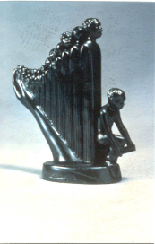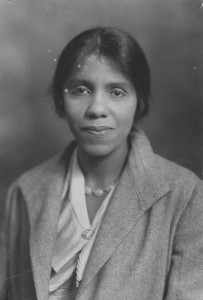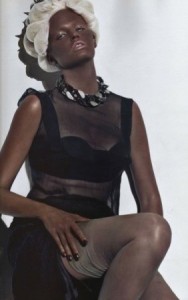Juliette Derricotte: Remembering Healthcare Denied
August 27, 2010
As told by Langston Hughes in November 1931 Juliette Derricotte was driving with three of her students from Fisk University in Nashville to her parent’s home in Georgia. Suddenly an approaching car, in order to pass a slower vehicle swerved toward the center of the road. Miss Derricotte, to avoid a collision, turned quickly to the side of the highway. Her wheels sank into a ditch, and her car turned over. The three students accompanying the Dean of Women were all badly injured. Passing motorists carried them into the nearest town, a small southern farming center. Here the white hospital refused point blank to give treatment to African-Americans, so the bruised and bleeding victims were not admitted. Instead they we taken to the house of a poor black woman of the town and there white doctors gave them attention, but without the necessary instruments and anesthetics that the hospital could have furnished.
Three of them were suffering intensely, but the least injured of the four, a young student was able to find a telephone. He called the nearest city in which a Negro hospital was located, and asked that an ambulance be sent for them. Late in the night the ambulance arrived, but on the way to the distant Negro hospital Juliette Derricotte died. A brilliant woman with much to offer was lost to America. Had not a white hospital refused to treat black people—even in so grave an emergency as this serious automobile accident—her life might have been saved.
Derricotte is most remembered today for her death and the national outrage it caused leading to a series of investigations; the NAACP became involved; the Commission of Interracial Co-operation of Atlanta made an investigation at the request of Fisk University and other organizations. Early in her career she worked with the YWCA traveling the globe studying in England and immersing herself in foreign cultures of India, Sri Lanka, and Burma. Through these experiences she was touched and transformed returning to Fisk University bringing her sense of global humanity and desire for a more just and human society.
Disparities persist in African-American health care while no longer a matter of overt discrimination the negative entrenched impact lingers. The burden of death and living remains far greater for people of color. In the United States, health disparities are well documented in minority populations such as African Americans, Native Americans, Asian Americans, and Latinos. When compared to whites, these minority groups have higher incidence of chronic diseases, higher mortality, and poorer health outcomes. Among the disease-specific examples of racial and ethnic disparities in the United States is the cancer incidence rate among African Americans, which is 10% higher than among whites. In addition, adult African Americans and Latinos have approximately twice the risk as whites of developing diabetes. Minorities also have higher rates of cardiovascular disease, HIV/AIDS, and infant mortality than whites.
While time chips away at the root causes of disparate health care Juliette Derricotte’s life and death endures as a reminder that universal health care should be a global concern, a human right and not a privilege.
African-Americans and Comprehensive Immigration Reform
August 19, 2010
Despite all the divisive rhetoric illegal immigrants are not for the most part taking away jobs from African Americans. However, illegal immigration is having a negative impact on low and unskilled wages upon which many African Americans rely, and all the more reason why we should support comprehensive immigration reform allowing a path to citizenship also known as amnesty.
There is a prevailing belief that only illegal aliens will do that which Americans will not. After U.S. Immigration and Customs agents raided a number of chicken processing plants in the Carolinas and under criminal indictment one plant went from 80 percent Latino to 70 percent African-American. As Mark Krikorian, Executive Director of the Center for Immigration Studies stated, “[A] lot of employers would rather not deal with black American workers if they have the option of hiring a docile Hispanic immigrant instead. [Illegal immigrants] are not going to demand better wages or time off. And frankly, a lot of bosses are thinking, I don’t want to deal with a young black male.” Unscrupulous employers prefer undocumented workers because they’re less likely to question working conditions for fear of losing their jobs or being deported.
Low wages make unskilled jobs unattractive to young black men. Wages are kept low because of illegal immigrtion and undermine the efforts of organized labor. As workers want more we should want more for them, particularly young black men, more than undesirable vocations. In the Underground Labor is Rising to the Surface Bear Stearns reports the true cost of illegal immigration:
• The illegal alien population of the U.S. is about 20 million – roughly the population of New York State.
• Between 4 and 6 million jobs have shifted to the underground economy since 1990. These are not “jobs Americans won’t do, but rather jobs Americans used to do.
• On the revenue side, the United States may be foregoing $35 billion a year in income tax collections because of the number of jobs that are now off the books.
• There are approximately 5 million illegal workers who are collecting wages on a cash basis and are avoiding both income and FICA taxes.
• The United States is hooked on cheap, illegal workers and is deferring the costs of providing public services to these quasi-Americans.
Deporting 20 million residents is unreasonable and unlikely. It is not unreasonable to expect our schools to increase the graduation rates for young black men and to equip them with the adequate skills and knowledge required of jobs with upward mobility. But education is not a panacea; at every education level the unemployment rate for blacks exceeds that of whites. The disparities among the college-educated and other evidence strongly suggest that even if the black educational attainment distribution was exactly the same as the white distribution, blacks would still have a higher unemployment rate than whites. Blacks and illegal immigrants are not competing for the same jobs. Without a renewed commitment to anti-discrimination in employment and job creation in black communities, high rates of black joblessness will likely persist.
A Good Day
June 25, 2010
Sunday past was Fathers Day. Unlike many others my father is still with us and we’re still building memories. I’d like to share this one: 1956 I was five years old. The family piled into the car on a Sunday drive from Gum Springs into the District of Columbia to visit my maternal great grandparents. A pony ride operated at the intersection of Richmond Highway and Fort Hunt Road. Little kids were lined up giddy with anxious excitement. The idea of taking his three kids on a pony ride delighted my father, and he asked if we wanted to. My brother and sister spoke up willingly. I had reservations. My father parked and along with my mother we waited in the car and watched him approach the attendant. Moments later he returned and started the car. My mother asked what happened. He responded, the man said they didn’t allow niggers to ride their ponies. We drove off everyone in silent wonderment. I can’t tell you how relieved I was at not being mounted on a beast and paraded about the smelly stable grounds. Though I had a cowboy outfit, I never wanted to be a cowboy. Like I said, it was a good day to be a nigger –for me at least–not so for my father. Can you imagine the indignities our forefathers endured?
Stony the road we trod,
Bitter the chastening rod,
Felt in the days when hope unborn had died;
Yet with a steady beat,
Have not our weary feet
Come to the place for which our fathers sighed?
We have come over a way that with tears has been watered,
We have come, treading our path through the blood of the slaughtered,
Out from the gloomy past,
‘Til now we stand at last
Where the white gleam of our bright star is cast.

Sculpture: Lift Every Voice and Sing by August Savage, 1939
Fashion’s Lack of Diversity
June 19, 2010
The lack of minority input was apparent when French Vogue’s October cover sported a white model in blackface—and to add insult to injury the entire magazine layout failed to include a single non-white model. At a time of the declining print media this was Vogue’s mad attempt to grab publicity and sell magazines regardless of political correctness. This sort of in your face racism is generally expected from the French.
In the U.S. the same disregard was aired on Project Runway when Emile Sosa a Black Dominican born New Yorker won weekly competition after competition only to lose the coveted grand prize to the lack luster performance of Seth Aaron Henderson, a white male. The reason given was that Sosa produced a line while Henderson produced a collection. If I understand the difference correctly, a collection is a designer’s creation for a single season meant to be more edgy and artistic while a line reflects a longer lasting commercial appeal. I thought it was about whoever produced the best work of redeeming quality. Reviewing past competitions evidence suggests line vs. collection became a new standard. Rather than give the Black designer the award the all white judges simply moved the goal post.
As for the dearth of diversity in print, Fashion editors claim their backs are against the wall, with their magazine’s sole income dependent on advertisers their decisions are based on advertiser preferences. It’s all business nothing personal or racist. The fear of low sales and advertisers pulling back prevents editors from putting dark-skinned models or celebrities on the covers of fashion/women’s magazines (which are mostly Caucasian owned). When ethnic consumers quit patronizing these advertisers then what? This same specious argument was used by Southern businessmen to oppose integration during the civil rights movement. Hindsight has shown by opening the doors of opportunity and embracing all, it enhances a business’s goodwill as well as its bottom line.
It all comes down to the personal taste of editors who wield an awful lot of power in the industry (remember the Devil Wears Prada). Now is the time for consumers to exercise their power. If fashion’s print media is to thrive and reverse the decline in readership it needs to become more relevant and by that more inclusive. It can only do so by recruiting more minority editors and writers, Blacks, Latinos, and Asians who are as acutely aware of their own ethnic aesthetic as they are the Anglo-American.
And minority consumers can make their preference known by insisting that industry giants the likes of Vogue, Marie Claire, Elle, Bazaar and Glamour begin to recruit minority editors and writers. Consumers can further demand the Council of Fashion Designers in American become more accountable and step up its efforts to bring diversity to the industry. A minority presence would put an end to stunts like Vogue’s black face.
The Imperfect Model Minority
June 11, 2010
Driven by sustained immigration and refugee resettlement during the 1970’s and 1980’s, Asian Americans have emerged as the fastest growing racial group and labeled as the model minority. The label ballooned into a myth. Statistics are often cited to back up their model minority status such as high educational achievement, overrepresentation at Ivy League and other prestigious universities, and a high percentage of Asian Americans working in white collar professions (jobs such as medicine, investment banking, management consulting, finance, engineering, and law).
The term “model minority” was coined in the mid-1960s by William Petersen to describe Asians in comparison to African-Americans. Asian Americans were chosen as an example of a minority group who could succeed by “merit” alone without “affirmative action.” This assumption ignored completely each group’s American history and cultural mores. The first Asians came here as willing workers. Blacks were here dragged in chains.
Modelminority.com writes: “While superficially complimentary to Asian Americans, the real purpose and effect of this portrayal is to celebrate the status quo in race relations. First, by over-emphasizing Asian American success, it de-emphasizes the problems Asian Americans continue to face from racial discrimination in all areas of public and private life. Second, by misrepresenting Asian American success as proof that the US provides equal opportunities for those who conform and work hard, it excuses US society from careful scrutiny on issues of race in general, and on the persistence of racism against Asian Americans in particular.”
The problems of Asian Americans facing racism are detailed in Rosalind S. Chou and Joe R. Feagin’s book The Myth of the Model Minority. They too suffer from poverty, unemployment, discrimination and attendant mental health issues. Psychiatrists have long linked mental health and racial discrimination. Cho Seung-Hui’s 2007 Virginia Tech Massacre illustrates how the problems of Asian Americans can go undetected and untreated. Racism and discrimination are stressful events that adversely affect health and mental health. They place minorities at risk for mental disorders such as depression and anxiety.
In their important book Black Rage, psychiatrists Grier and Cobbs draw from records of patients to show that many psychological problems of African Americans are the result not only present-day discrimination but also of the accumulating impact of years of past discrimination. As they note, “a few black people may hide their scars, [but] most harbor the wounds of yesterday.” One advantage that African Americans have over many other Americans of color is many generations of building up a collective knowledge of white racism and of the strategies that enable people to resist it. In contrast, the collective memory of resistance strategies among Asian Americans seems relatively weaker and generally less effective in providing significant protection. (Chou and Feagin)
It’s not a perfect world and one can ill afford to ignore or underestimate the consequences of racism and discrimination as experienced by people of color.






